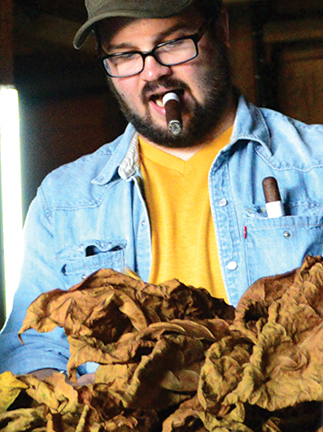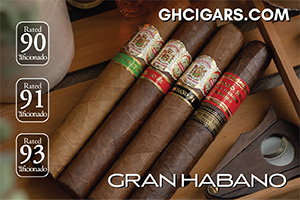Humidity, Temps and Cigars: A Discussion with Nicholas Melillo

Cigar Press – How do you personally like to keep your cigars?
Nicholas Melillo – First I would like to express that the following are my personal opinions that I have developed from over 20 years smoking and storing cigars. I am not a scientist by any means but a lover of the leaf. The first step for my personal storage is an excellent seal to ensure proper conditions. Any excess of air / oxygen that is let into a humidor can effect your cigars in a number of ways. It can speed up the aging process via oxidation, dry out or over humidify your cigars. All depending on your location.
CP – What level do you like to keep your humidity inside your humidors?
NM – My personal preference for humidity levels for my home humidor depends on where I am and the time of the year. In Nicaragua for example there is 6 months of dry season and 6 months of rainy season. During dry season I will tend to keep my humidor around 70% since the outside humidity will tend to reach 55% humidity. Remember once you remove your cigar from storage it is affected by the climate immediately. For example in Colorado the humidity can get as low as 35%. Within a very short period of time your cigars begin to dry out when exposed to the elements. In which case I like to set my humidor a bit higher, say 72% and I tend to smoke in a room of about 60 – 65% humidity. During rainy season in Nicaragua the humidity can reach roughly 85% in which case I will tend to store my cigars around 65%… This would be my typical preference for cigars I plan on smoking within a 1-3 year period. If I am looking to age cigars for longer periods of time I usually tend to store them at 60-65 humidity and temperature… This will tend to slow down the aging process and main
CP – Let’s look at a point of no return, when the oils of the cigar evaporate. When can that occur?
NM – Controlling humidity and temperature are essential from the beginning stages of growing, curing, to the production floor and finally the aging rooms. When tobacco is harvested it enters the curing barns at 80% – 90% moisture content (the quantity of water contained in a material). This means, like the human body, the leaf is comprised mostly of water. 40-60 days in the curing barns tobacco undergoes slow oxidation and degradation of carotenoids (organic pigments). During this process the leaves turn from green to yellow to brown and the moisture content within the leaf begins to be reduced. If the process happens to fast to leaf will become patchy and spotted. If cured to slow the leaf could begin to rot and form mold due to excess humidity. The tobacco is usually taken down at moisture content of about 20% at which point it will enter the fermentation process.
CP – How can you control the environment in the curing process?
NM – Dark air cured tobaccos / cigar tobaccos for the most part do not used controlled environments such as flue cured tobaccos. It takes a keen eye, experienced touch and proper adjustments in order to cure and control humidity levels in the curing barns. This is usually done by the opening and closing of flaps on the side of the barns. Many farmers are so in tune with their tobacco they do not need gauges or instruments to determine when the tobacco is ready for fermentation. Observation and touch determines when tobacco is ready for the next stage.
NM – But let’s touch back on the oils of tobacco evaporating for a minute. Fermentation is comparable to controlled composting which is an all natural process. The combination of pressure and moisture triggers raised temperatures and releases ammonia. Tobacco is typical stacked into bulks of 5,000-7,000 lbs and flipped over 1–3 years, depending on the country of origin, grade and variety. Temperatures are monitored until the tobacco reaches a state of perfect combustion and flavor. If tobacco is under fermented it will taste bitter/green and will not burn properly. If it is over fermented it will eventually become tender and all the oils and flavor will be lost. It all depends on the proper humidity levels, moisture content, and temperature that the fermentation bulks are kept at. Lower temperatures over a longer period of time ensures the preservation of oils and flavor. I provide this brief summary to point out that the same is true for the finished cigars yet on a much smaller scale, which is referred to as micro-fermentation or more commonly known as aging. Cigars are in a way continuing the fermentation process and will react differently depending on the conditions they are stored. If you are storing your cigars above 70 degrees and 72 % humidity the tobacco will continue to “ferment.” It is in my opinion if cigars are stored at higher humidity levels and temperatures for more than 3 years the tobacco will continue this micro-fermentation process until oils evaporate leaving the cigars flavorless and with no strength. Now this is not an absolute truth but a generalization because it all depends on the blend of the cigar and the use of thicker and thinner tobaccos. A cigar consisting of mainly lower priming leaves will age much faster than a cigar consisting of heavier / higher priming leaves. I always suggest to experiment in testing blends at different stages/times so one can begin to become familiar in how different cigars age over time. It is general thought that the older cigars are the better they taste. This is not always the cause. Everyone has their own personal preference but it’s a shame to have this misconception and people age cigars for many years only to find out there is no strength or flavor left in their prized possessions. Oils in cigars will also start to evaporate at temperatures below 55 degrees F. Cigars will begin to dry out and loose the essential flavors in the leaf because they become inactive and dissipate.
CP – When does mold begin to form?
NM – The triggering point of mold is excess humidity of 75% and temperatures above 80 degrees F. If mold forms on cigars it is usually Eurotium mold which is harmless and does not form any toxins. Eurotium is usually mistaken for plume and is white and fluffy in appearance It can be wiped off or you can use a bit of vinegar and water to remove which will not effect the cigar in any way. Aspergillus flavus is a more harmful fungus and is usually powdery masses of yellow and green spores which form around 86 degrees F and humidity of 80% or higher. I suggest these cigars be discarded immediately and your humidor regulated asap. My general rule of thumb is to keep temperature and humidity of 65 – 70 respectively to avoid any out breaks. If you want to be safe stick around the 65 mark.
CP – What temp is too high for cigars, and what can happen?
NM – Excess temperatures of 75 degrees can but cigars at risk of Lasioderma serricorne ,commonly known as tobacco beetles, to hatch. This beetle lays microscopic eggs which are usually eliminated by manufactures fumigating and freezing product before shipping. But occasionally eggs survive these measures and slip by unseen by forming a protective shield. When humidor temperatures reach 75 degrees F and higher it can produce the right environment for beetles to hatch and reek havoc.
CP – What if the temps are too low?
NM – If temperatures begin to dip below 60 degrees F it increases the risk of the cigars to dry out and for oils to dissipate.
CP – How do different tobaccos burn differently at different levels?
NM – Tobacco is like a sponge and will burn much faster and hotter at low humidity levels. This will completely affect the blend in a negative way causing the tobaccos to burn hot and to fast. It can also cause the wrapper leaf to crack. As with high humidity levels within the cigar it can cause the cigar to burn bitter, tight, and also mute a lot of the flavors within the blend. Over humidified cigars can also cause the wrapper leaf to expand and crack. Once the cigar is ignited it causes the filler tobaccos to expand almost instantaneously. Cigars kept at proper humidity levels are elastic enough to handle the expansion. But If over humidified the heat expansion within the filler tobaccos will crack the wrapper tobacco – especially if it is a thinner leaf such as CT shade, Ecuador Habano or Sumatra varieties. Over humidification can also affect the filler tobaccos. If blends use many heavier leaves they hold more moisture, which in turn can cause combustion problems and the cigar to be re-light many times. A general rule of thumb is cigars are ideal at 12% moisture content. Unfortunately the general public does not have easy access to these types of gauges but they used by manufacturers.
CP – If someone buys cigars, whether for a humidor with boxes or single cigars, or both and they want to age them for the long term, allowing the tobaccos to meld further, what is the best humidity/temp levels?
NM – This all depends on personal preference and the individual blends and brands. As discussed above I usually keep my humidor around 65 – 70% up to 3 years. This is a good time period for the cigars to “merry” and become more pleasant and balanced. Again it is all personal preference and for this reason experimentation at different time periods is highly recommended. For aging long term (longer than 3 years) I suggest keeping humidors at lower temperatures and humidity levels – 60% – 65% and roughly the same temperature. This ensures to slow down the aging process to maintain oils and flavor. I have smoked numerous cigars from the 1990’s over the years and it is rare that I enjoy one. After the excitement of hold such a rare cigar wares away I am usually left with no flavor and an un-pleasant bitterness. Just as with a bell curve there is a point where cigars over matured and begin to dissipate in flavor. You have a much better chance at maintaining the flavor at lower humidity levels. The trick is to find your “sweet” spot.













